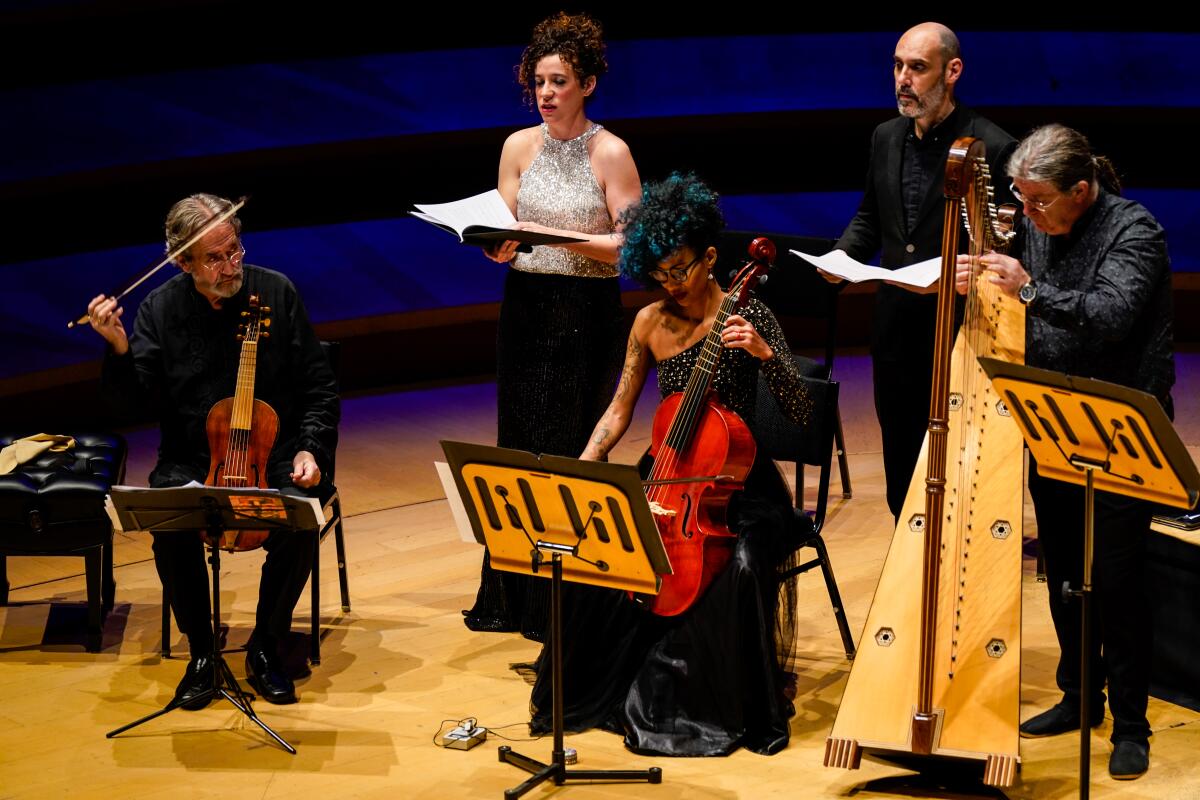Review: At Disney Hall, early music legend Jordi Savall shows how his Catalan roots may be ours

- Share via
When we invoke the Spanish Golden Age, that thriving of arts and culture in the 16th and 17th centuries, we think, inevitably, of Cervantes, El Greco, Velázquez. In Madrid, Spaniards are daily reminded of a golden century’s glories in the city’s central Plaza Mayor.
We too are ever in the midst of the Spanish Golden Age. “Don Quixote,” in particular, is as inescapable as, well, Orpheus and Eurydice. Strauss’ “Don Quixote” tone poem happened to be on the Los Angeles Philharmonic bill over the weekend. Salman Rushdie’s latest novel is “Quichotte.”
But when it comes to music, most from the period has lost its luster for contemporary listeners. The most celebrated composer, Tomás Luis de Victoria, may be considered an equal of, but is not nearly as well known in early music circles as, Palestrina or Orlando di Lasso. The latter’s motet “Lagrime di San Pietro,” performed by the Los Angeles Master Chorale in a profound Peter Sellars production, has been touring the world (it was in Toronto last weekend).
Sunday night at Walt Disney Concert Hall, the Catalan viol virtuoso and conductor Jordi Savall brought instrumentalists and singers to dig deeper into an Iberian Baroque thus all but unknown. Composers’ names would be recognizable only to the avid scholar. Savall wound up in Mexico City, demonstrating that the Spanish Golden Age DNA strands may be more plentiful in the New World than normally realized.
That Savall is a master of an instrument long out of currency (the viol being an ancestor to the modern string family) may suggest a musician confined to a limited realm, but no one in early music has ventured as far as he has during the last half century. He has founded various instrumental and vocal ensembles, and he conducts a range of repertory. Sunday’s program may have been obscure, but Savall’s latest recording, released in November, is a sublimely passionate and compassionate performance of Handel’s “The Messiah.”
In fact, Savall is most famed as an inveterate cultural campaigner. He is known for his grand projects exploring international musical exchange, be it in earlier centuries, between East and West, between Christian and Arab. In an illuminating recent one, he followed in music slave routes. Through more than 100 recordings, he has surveyed the hidden sound worlds of key cities (Venice, Jerusalem, Granada), of different eras, of historical, cultural and spiritual figures. Many releases include beautifully illustrated and seriously researched hardback books.
With music history on his side, Savall has, moreover, become a force for world peace. Carnegie Hall just announced his perspectives series next season in New York, where he will give voice to artists in times of oppression through music, from the Balkans and the Roma and Armenian diasporas.
Unsurprisingly, Savall’s look at his native Spain was full of the subtle intersection of cultures in a Spain that was more than a kingdom of cultural grandeur. His splendor, heard in 22 short works, alternating vocal with purely instrumental, was a look at the people.
The forces were modest. Savall brought but six members — viol, harp, guitar, percussion — of his ensemble Hespèrion XXI, along with six voices from his La Capella Reial de Catalunya. Lixsania Fernández was member of both ensembles, a captivating mezzo-soprano who fiddled on tenor viol as she sang. Rather than represent the grandeur of the court, where surely there would be larger forces and brass and winds, or even on the cathedral, the revelation here was on life as more commonly lived.
There were romances and the early, original forms of all those Spanish dances that went on to pervade Europe and the world at large, such as the fandango and seguidilla. Unfortunately, the ensalada, that delicious Spanish nonsense genre, was dropped from the program, but we got folias, in which a musical depiction of madness is a patent excuse for leaving inhibitions at the door, one thing be allowed to lead to another, no matter where that takes you.
First came a moresca, a dance derived from the cultural interaction and battles in medieval Spain between Christians and Moors. The songs, whether sacred or secular, were all love songs, always personal, expressions of one on one.
From this, we got a taste of times told from the inside. Some of it may have seemed on the overly cozy, idealistic side. Life had to be harsh in those days. But Savall is simply the kind of magnificent player, and his ensembles such vehicles of unqualified community and joy, that sweetness even seeps into expression of sorrow. Then again, it could be that we, in our angst-ridden world, are the ones missing something.
The program ended with yet another dance, a guaracha, by the 17th-century Mexican composer Juan García de Zéspedes. “Ay, que me abrazo ay” is one of Savall’s many signature pieces, and he performed and recorded in different guises, usually with swinging brass. Here his singers brought a playfully erotic quality to a Nativity text that might well have landed them alight on the stake in the Old World.
The New World gilded the Spanish Golden Age in its own way. A century later, the guaracha became a Cuban dance, and you’ve surely heard its influence in popular Cuban music. Look with insight into a small corner of the musical past, we learn from Savall, and history itself is folia writ large.
More to Read
The biggest entertainment stories
Get our big stories about Hollywood, film, television, music, arts, culture and more right in your inbox as soon as they publish.
You may occasionally receive promotional content from the Los Angeles Times.










